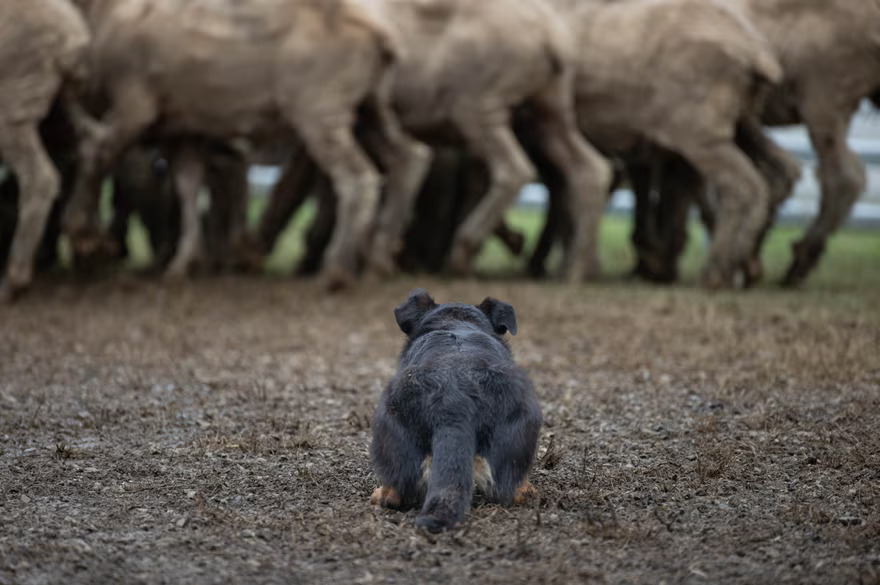As trainers and their dedicated canine companions come together for the Working Dog Challenge in the central west of the state, competing for substantial prize money, Mike Bowers skillfully captures the relentless spirit of Australia’s hardest-working animals in action.
The echoes of kelpies, collies, and a lone cattle dog resound through the sale yard, cutting through the ambient sounds as working dogs expertly navigate the mud, cowpats, and puddles.
In the heart of central west New South Wales, the Working Dog Challenge is in full swing, featuring approximately 275 dogs competing across five categories for one of the most substantial prize pools in the country. This includes an impressive $5,000 prize for the winners in both the open sheep and cattle events.

Megan and Peter Rutherford embark on a breezy 10-minute journey from their homestead in Blayney to the picturesque training grounds, where the artistry of training working dogs has been their passion for over a decade.
In the words of Peter Rutherford, “It’s a delicate dance, finding that sweet spot where you push your dog to excel while ensuring they revel in the joy of the work. Stay composed, and you’ll find your dog remains calm, and so do the livestock.”
At the recent novice cattle trial, Rutherford and his brilliant kelpie Quads clinched the coveted first place. Megan Rutherford’s partner-in-crime, Mars, gracefully secured the third spot in the open cattle trial. Megan attributes this triumph to the countless hours spent harmonizing with Hereford cattle and Merino sheep on their charming property.


For numerous years, I’ve involved my children in the rewarding experience of mustering, and it wouldn’t be possible without our trusty dogs,” she expresses. “It’s akin to having an additional companion – they adore it, it’s their passion.”
Balancing the responsibilities of farming, parenting, and overseeing a working dog stud has spurred inventive solutions for preparing the Rutherfords’ dogs. Peter Rutherford confesses that a part of their training regimen is more of “a social affair.”
“We’ve converted an old shed into a makeshift training ground with sheep panels, and with a couple of friends, we engage in training while bringing out a few pups,” he shares. “We spend a couple of leisurely hours there, enjoying a cup of coffee, maybe a beer. With three kids, we don’t make it to the pub as often as we used to.”
Training a working dog presents challenges, but it’s a venture that not only brings job satisfaction but can also have financial rewards.
At the auction, seamlessly woven into the thrilling trials, 18-year-old Lilli Tickle proudly introduces her inaugural canine companion, Daisy—a vivacious 12-month-old red and tan kelpie. The bidding unfolds, and to Tickle’s delight, Daisy fetches the precise sum of $4,000, the exact figure she had envisioned. Tickle envisions these funds as a catalyst for her ongoing canine training pursuits.
“This might just be the inception of something greater,” she muses. “I’m committed to persisting in this journey, considering the prospect of acquiring younger pups for future training endeavors.
The auction held in Carcoar over the weekend saw an average price of $5,733, a notable difference from last year’s remarkable record set by Eve, a black and tan kelpie, which fetched an impressive $49,000. Despite the market’s tightening conditions, auctioneer Tom Card asserts that sales remain robust, attributing this resilience to the pivotal role dogs play in alleviating the persistent shortage of human labor in agriculture.
“This has undeniably been a challenging year for the livestock sector, impacting markets across the board,” he observes.
“In the current landscape, it’s a formidable task to secure a recent graduate willing to work on a farm for anything less than $50,000. Contrastingly, investing $20,000 or $30,000 in a highly skilled, fully trained working dog capable of tirelessly contributing throughout the day—it’s a decision that simply makes sense.
Over the weekend, the spotlight fell on Grace Halsted’s exceptional two-year-old black and tan kelpie, Karana Spud, fetching an impressive $14,000. With a lifetime dedicated to the companionship of working dogs, Halsted followed the footsteps of her partner, Zac Ede, venturing into the world of trialling.
“We boast a versatile mix – collies, kelpies, whichever proves effective during the week is who we bring along,” she explains. “It’s not a competition in our eyes; it’s about fulfilling a task.
“The primary stumbling block for most is nerves, as it inevitably affects the dog. The key is maintaining the same approach here as we do while working with them at home.”

“Kelpies come into this world with one inherent trait – a natural inclination to work. Dogs are born with instinct,” Halsted notes. She highlights that this instinct, coupled with their high energy, can sometimes lead working dogs to end up in shelters.
“People acquire a puppy inspired by shows like Muster Dogs and place them in a backyard, unknowingly driving the dog to frustration. These dogs possess a natural instinct to work, and when confined, they may bark excessively out of boredom.
“If that’s the case, perhaps choosing a poodle would be a more suitable option.”


Halsted and Ede make a triumphant return to their abode in Scone, a voyage spanning over 300 kilometers. Meanwhile, Spud embarks on a journey to South Australia, clinching the coveted first place in both the open cattle trials, entitling them to a grand prize of $5,000, and the maiden poll Dorset sheep trials, adding another $1,000 to their triumph. Halsted expresses that the arduous journey is unquestionably justified.
“Watching this sport is an unparalleled experience – witnessing a 20-kilogram dog assert its control over 1,500 kilograms of beef is truly mesmerizing. It’s a spectacle of pure incredibility.”
